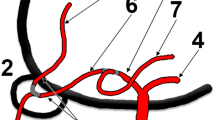Abstract
Purpose
To describe a case of a possible new variant of persistent primitive olfactory artery (PPOA).
Case report
A 93-year-old man with left hemiparesis and dysarthria underwent cranial magnetic resonance (MR) imaging and MR angiography using a 3-T scanner. MR imaging showed an acute infarction at the right precentral gyrus. MR angiography showed no steno-occlusive lesions, but the distal A1 segment of the left anterior cerebral artery (ACA) took an extreme anterior course and made a hairpin turn, connecting to the A2 segment, which is indicative of type 1 PPOA. In addition, there was a faintly visualized small artery arising from the hairpin turn. Subsequent computed tomography (CT) angiography showed that the hairpin turn had a mildly dilated arterial lumen, and an extremely tortuous orbitofrontal artery arose from the hairpin turn.
Discussion
There are five types of PPOA. Type 1 is most common, and usually no arterial branch arises from the hairpin turn, except for in type 3 PPOA, which has a branch continuing to the anterior ethmoidal artery arising from the hairpin turn. Using MR and CT angiography, we diagnosed a case of type 1 PPOA associated with the orbitofrontal artery arising from a hairpin turn. A similar previously reported case was diagnosed using catheter angiography.
Conclusion
The present case may be a new variant (type 6) of PPOA. Because the orbitofrontal artery was relatively small in caliber and its proximal segment extremely tortuous, CT angiography had superior utility to MR angiography for demonstrating this variation.



Modified from reference [9]). ACA anterior cerebral artery, AEA anterior ethmoidal artery, AMCA accessory middle cerebral artery, ICA internal carotid artery, OFA: orbitofrontal artery, PPOA persistent primitive olfactory artery
Similar content being viewed by others
References
Horie N, Morikawa M, Fukuda S, Hayashi K, Suyama K, Nagata I (2012) New variant of persistent primitive olfactory artery associated with a ruptured aneurysm. J Neurosurg 117:26–28
Kim MS, Lee GJ (2014) Persistent primitive olfactory artery: CT angiographic diagnosis and literature review for classification and clinical significance. Surg Radiol Anat 36:663–667
Nozaki K, Taki W, Kawakami O, Hashimoto N (1998) Cerebral aneurysm associated with persistent primitive olfactory artery aneurysm. Acta Neurochir (Wien) 140:397–401
Pendharkar H, Bhattacharya K, Yadav N, Jabeen S (2021) Persistent primitive olfactory artery: three cases. J Comput Assist Tomogr 45:315–317
Rădoi PM, Rusu MC, Dincă D, Toader C (2021) Combined rare anatomic variants: persistent primitive olfactory artery and azygos pericallosal artery. Surg Radiol Anat 43:1305–1308
Uchino A, Baba Y (2021) Type 2 persistent primitive olfactory artery associated with bilateral ophthalmic arteries arising from the middle meningeal arteries diagnosed by magnetic resonance angiography. Surg Radiol Anat 43:1948–1950
Uchino A, Ishihara S (2021) Type 4 persistent primitive olfactory artery associated with contralateral accessory middle cerebral artery arising from the fenestrated segment of the distal anterior cerebral artery. Surg Radiol Anat 43:1951–1953
Uchino A, Mochizuki A (2021) Persistent primitive olfactory artery associated with early bifurcated accessory anterior cerebral artery. Surg Radiol Anat 43:1731–1733
Uchino A, Ohno H, Ogiichi T (2021) Persistent primitive olfactory artery without a hairpin turn. Surg Radiol Anat 43:231–234
Uchino A, Saito N, Kozawa E, Mizukoshi W, Inoue K (2011) Persistent primitive olfactory artery: MR angiographic diagnosis. Surg Radiol Anat 33:197–201
Author information
Authors and Affiliations
Contributions
AU carried out the study design and drafted the manuscript. All authors reviewed the manuscript critically, and have read and approved the final manuscript.
Corresponding author
Ethics declarations
Conflict of interest
We declare that we have no conflict of interest.
Additional information
Publisher's Note
Springer Nature remains neutral with regard to jurisdictional claims in published maps and institutional affiliations.
Rights and permissions
About this article
Cite this article
Uchino, A., Nakadate, M. Orbitofrontal artery arising from a hairpin turn in type 1 persistent primitive olfactory artery: a possible new variant (type 6). Surg Radiol Anat 44, 527–530 (2022). https://doi.org/10.1007/s00276-022-02914-x
Received:
Accepted:
Published:
Issue Date:
DOI: https://doi.org/10.1007/s00276-022-02914-x




